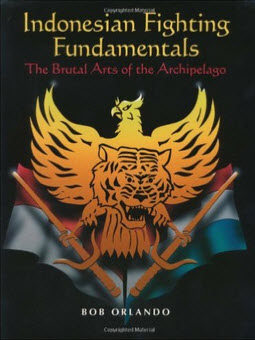
Indonesian Fighting Fundamentals
September 09, 2012
Adhesion requires the fighter to move in very close to his opponent and remain there. That is a scary place to be … very few really know how to fight ‘inside.'”
Bob Orlando
 The 1996 book
Indonesian Fighting Fundamentals: The Brutal Arts of the Archipelago
by Bob Orlando is one of my favorite martial arts books (and I have read hundreds).
The 1996 book
Indonesian Fighting Fundamentals: The Brutal Arts of the Archipelago
by Bob Orlando is one of my favorite martial arts books (and I have read hundreds).
Why is it so good? This is something I’ve thought a lot about as I’ve tried to follow in his and other writer’s footsteps and use words to discuss fighting arts. Most martial arts books, going back hundreds of years, give a little history, then attempt to document techniques and forms.
Most Wing Chun books have a series of photos of someone doing Siu Lum Tao and Chum Kiu. Then there will be a number of Kung Fu Illustrated-style illustrations of a series of techniques. The instructor in their Sunday best beats up a compliant student with a series of typical techniques from the style.
This is cool, but does it teach us anything worth learning?
Bob Orlando, following more in the footsteps of Miyamoto Musashi and Sun Tzu, chooses to focus on the principles of his art. He breaks them down into five major groups: adhesion, whiplash, shearing, seating, and gyroscopic rotation.
The techniques he shows are there to demonstrate or show an instance of the technique, not to teach the technique itself. Let me say this again: you can’t learn martial arts from a book!
But martial arts, especially subtle and sophisticated arts like Penjat Silat and Wing Chun, benefit from explanation which discusses the principles and uses metaphor to try and tell you what a move is like or feels like or wants to accomplish.
Despite major differences, the Penjat Silat and Kuntao Orland describes in his book has many parallels with other arts I am familiar with, such as Wing Chun and Escrima. The empty-hand approach of all three styles takes the fight close. Wing Chun “goes into the house to fight the fire” and “receives what comes and follows what goes.” Wing Chun sticks . Penjat Silat use “adhesion” which is “the first and most important principle.” They adhere in order to use the “tactile sense to monitor and control.”
All three styles employ a parry-check style of blocking and training methods which involve flow and trapping. They all use elbows extensively. Wing Chun has an entire form, Biu Jee, that delivers an elbow every other technique. Penjat Silat has three distances of elbow, a subtle reading on a technique Wing Chun would call 2nd Gate.
I’m re-reading Indonesian Fighting Fundamentals , so I’ll probably have more to say later on – I find I am understanding it much better now and seeing all the similarities. My teacher notes how high-level martial arts all start to look similar from a certain level.
